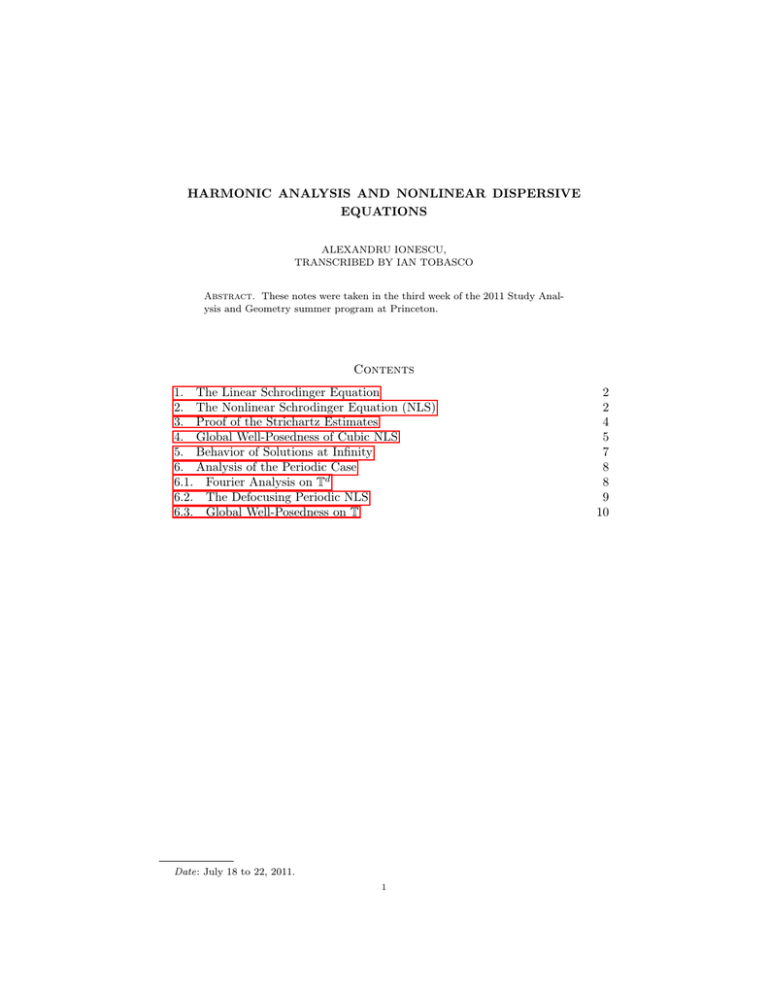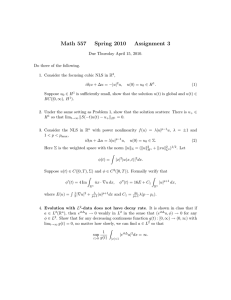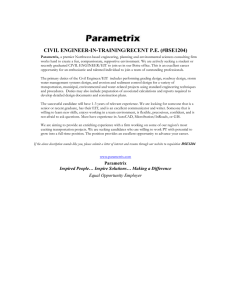HARMONIC ANALYSIS AND NONLINEAR DISPERSIVE
advertisement

HARMONIC ANALYSIS AND NONLINEAR DISPERSIVE
EQUATIONS
ALEXANDRU IONESCU,
TRANSCRIBED BY IAN TOBASCO
Abstract. These notes were taken in the third week of the 2011 Study Analysis and Geometry summer program at Princeton.
Contents
1. The Linear Schrodinger Equation
2. The Nonlinear Schrodinger Equation (NLS)
3. Proof of the Strichartz Estimates
4. Global Well-Posedness of Cubic NLS
5. Behavior of Solutions at Infinity
6. Analysis of the Periodic Case
6.1. Fourier Analysis on Td
6.2. The Defocusing Periodic NLS
6.3. Global Well-Posedness on T
Date: July 18 to 22, 2011.
1
2
2
4
5
7
8
8
9
10
2
ALEXANDRU IONESCU, TRANSCRIBED BY IAN TOBASCO
1. The Linear Schrodinger Equation
We begin with the linear Schrodinger equation,
(i∂t + 4x ) u = 0
d
for u : R × R → C, and with initial data u (x, 0) = φ (x). Taking the Fourier
transform on Rd ,
Z
fˆ (ξ) =
f (x) e−ix·ξ dx,
Rd
the equation becomes
i∂t û (ξ, t) − |ξ|2 û (ξ, t) = 0.
This has the solution
2
û (ξ, t) = φ̂ (ξ) e−it|ξ| .
So for φ ∈ S R we may write
Z
u (x, t) = eit∆ φ (x) =
φ (x − y) K (y, t) dy
d
Rd
with kernel
2
K (y, t) = Ct−d/2 ei|x| /(4t) .
Here are some properties of the linear Schrodinger flow:
Proposition 1.1. For initial data φ:
(1) ||eit∆ φ||L2 (Rd ) = ||φ||L2 (Rd ) for all t ∈ R.
(2) eit∆ ◦ eis∆ = ei(t+s)∆ for all t, s ∈ R.
(3) eit∆ ◦ τx0 = τx0 ◦ eit∆ for all t ∈ R, x0 ∈ Rd , where (τx0 f ) (x) = f (x − x0 ).
2
(4) eit∆ ◦ δr = δr ◦ ei(t/r )∆ for all t ∈ R, r ∈ R+ , where (δr f ) (x) = f (x/r).
Exercise 1.2. (a) Prove these identities.
(b) Is it true that limt→0 eit∆ φ = φ? In what sense and for what kind of functions
φ?
2. The Nonlinear Schrodinger Equation (NLS)
The simplest nonlinearity to introduce is the so-called power nonlinearity. The
equation is now
(i∂t + 4x ) u = µu|u|p−1
with initial data u (x, 0) = φ (x). Here, µ = ±1 and p > 1. Taking the Fourier
transform and solving the ode results in the Duhamel formula:
Z t
u (t) = eit∆ φ − i
ei(t−s)∆ N (s) ds
0
where
N (s) = µu (t) |u (t)|p−1 .
This is not an explicit formula for u. But we can approximate u via a perturbative
iteration scheme,
u1 (t) = eit∆ φ,
un+1 (t) = e
it∆φ
Z
−i
0
t
ei(t−s)∆ µun (s) |un (s)|p−1 ds.
HARMONIC ANALYSIS AND NONLINEAR DISPERSIVE EQUATIONS
3
We can only hope for this scheme to work for short enough time and for small
enough functions. This is to ensure the second term does nothing more than correct
small errors in the initial guess. But sometimes a different approximation scheme
is needed. Then we’d write
i∂t u − u|u|p−1 = −4x u,
and with the anzatz |u| = ct (??) we’d get
p−1
u (x, t) = u (x, 0) e−it|u(x)|
.
This would produce an iterative scheme to deal with functions which are large in
short time. But in this lecture we’ll assume we’re working where the first scheme
is convergent.
It will be useful to understand which quantities are conserved under the time
evolution of NLS.
Exercise 2.1. Prove (formally) the conservation of mass and energy for solutions
of the NLS: if u is a “nice” solution on an interval I, then the quantities
Z
M (t) =
|u (x, t)|2 dx,
Rd
Z
Z
µ
1
2
|4x u (x, t)| dx +
|u (x, t)|p+1 dx
E (t) =
2 Rd
p + 1 Rd
are conserved.
Now assume φ ∈ H σ Rd . For the iteration scheme to work, we need a space
X σ = X σ (I) so that
eit∆ φ ∈ X σ (I) if φ ∈ H σ
and so that
Z t
ei(t−s)∆ f (s) |f (s)|2 ds ∈ X σ (I) if f ∈ X σ (I) .
0
Exercise 2.2. Assume d = 3, p = 3. Show the perturbative scheme produces
a solution in X σ (I) = C (I : H σ ), provided that σ is sufficiently large and |I| is
sufficiently small. Hint: Sobolev embedding.
The perturbative scheme only produces local solutions. To go from local to
global we have to use the conserved quantities. Another useful tool is the Strichartz
estimates:
(1) If (q, r) is an admissible pair, i.e., (q, r) ∈ (2, ∞] × [2, ∞], 2/q + d/r = d/2,
then
||eit∆ φ||Lqt Lrx .q ||φ||L2 .
(2) If (q, r) , (q, r) are admissible pairs, then
Z
t i(t−s)∆
e
N (s)Lq Lr .q,q ||N ||Lq0 Lr0 .
−∞
t
x
t
x
Let’s try to understand what (1) means. Let d = 4, and q = r, then we get
||eit∆ φ||L3x,t . ||φ||L2 .
This says the L3 -norm of eit∆ φ is finite for a.e. t, so long as we have φ ∈ L2 . So the
forward-time evolution has a smoothing effect. And this also says that the L3 -norm
4
ALEXANDRU IONESCU, TRANSCRIBED BY IAN TOBASCO
of eit∆ φ has to decay forward in time. In the next section we’ll prove the Strichartz
estimates.
3. Proof of the Strichartz Estimates
First we write the Strichartz estimates in a more conceptual way:
(1) If (q, r) is an admissible pair, i.e., (q, r) ∈ (2, ∞] × [2, ∞], 2/q + d/r = d/2,
then
||eit∆ φ||Lqt Lrx .q ||φ||L2 .
(2) If (q, r) is an admissible pair, then
Z
t i(t−s)∆
e
N (s)L∞ L2 ∩Lq Lr .q ||N ||L1 L2 +Lq0 Lr0 .
t
−∞
x
x
t
t
x
t
x
Exercise 3.1. (a) Show that if f : Rd × I → C is a measurable function and
p, q ∈ [1, ∞] then
Z
||f ||Lpt Lqx =
f g dxdt.
sup
||g||
Rd ×I
p0 q 0 =1
Lt Lx
(b) Show that if (q, r) , (q, r) are admissible pairs, q ≤ q, then
||f ||Lq Lr ≤ ||f ||Lqt Lrx ∩L∞
2,
t Lx
t
x
||f ||Lq0 Lr0 ≥ ||f ||Lq0 Lr0 +L1 L2 .
t
x
t
x
t
x
Our goal is to prove the Strichartz estimates. First we recall the concept of
fractional integration.
Exercise 3.2 (Fractional Integration). Prove that
||f ? |y|−γ ||Lq (Rd ) ≤ Cp,q ||f ||Lp (Rd )
if 0 < γ < d, 1 < p < q < ∞, and q −1 = p−1 − (d − γ) /d.
And next, complex interpolation.
Exercise 3.3 (Complex
Interpolation).
Let S = {z ∈ C : < (z) ∈ [0, 1]} and assume
that Tz : S Rd → L1loc Rd , z ∈ S, is an analytic family of operators, i.e., the
map
Z
z 7→
Tz (f ) · g dx, f, g ∈ S Rd
Rd
is analytic (and bounded) in int (S) and continuous in S. Assume that p0 , q0 , p1 , q1 ∈
[1, ∞] and
||Tiy ||Lp0 →Lq0 ≤ M0 ,
||T1+iy ||Lp1 →Lq1 ≤ M1 .
Then, for all θ ∈ [0, 1]
||Tθ ||Lpθ →Lqθ ≤ M01−θ M1θ
−1
where p−1
θ = (1 − θ) /p0 + θ/p1 , qθ = (1 − θ) /q0 + θ/q1 .
HARMONIC ANALYSIS AND NONLINEAR DISPERSIVE EQUATIONS
5
Now we prove the first Strichartz estimate. We have the dispersive estimates
||eit∆ ||L2 (Rd )→L2 (Rd ) . 1,
||eit∆ ||L1 (Rd )→L∞ (Rd ) . |t|−d/2 .
By interpolation,
||eit∆ ||Lr0 (Rd )→Lr (Rd ) . |t|−d(1/2−1/r) .
Now we have the T T ∗ argument. We want
||eit∆ φ||Lqt Lrx .q ||φ||L2 .
This is equivalent to
Z
Rd ×R
eit∆ φ (x) g (x, t) dxdt .q ||φ||L2 ||g||Lq0 Lr0 ,
which is equivalent to
Z
Rd ×R
x
t
2
e−it|ξ| eix·ξ g (x, t) dxdtL2 .q ||g||Lq0 Lr0 ,
ξ
t
x
which is equivalent to
Z
Z
g (x, t) g (y, s)K (x − y, t − s) dxdtdyds .q ||g||2 q0
Rd ×R
Lt Lrx0
Rd ×R
where K is the kernel of the free Schrodinger flow. Note that to use Fubini’s
theorem here we needed absolute integrability. This does not hold in general, but
we can instead consider g to be a simple function, or perhaps in the Schwartz class.
Then we can use a density argument to extend to more general g.
But by the dispersive estimate,
Z Z
g (x, t) h (y, x) K (x − y, t − s) dxdy . G (t) G (s) |t − s|−d(1/2−1/r)
Rd
Rd
where
Z
G (t) =
1/r0
|g (x, t)| dx
.
r0
Rd
The desired bound now follows from Holder’s inequality and fractional integration.
The admissibility condition will drop out of this as an algebraic condition. And
note that to apply the fractional integration result we need q > 2. The theorem
turns out to be true for q = 2, d ≥ 3, but this is a more difficult (and recent) result
due to Tao.
Exercise 3.4. Prove the remaining Strichartz estimates.
4. Global Well-Posedness of Cubic NLS
In this section we’ll discuss global well-posedness of the cubic nonlinear Schrodinger
equation,
(i∂t + 4x ) u = u|u|2
with initial data u (x, 0) = φ (x) on R3 . Recall the Duhamel formula,
Z t
it∆
u (t) = e φ − i
ei(t−s)∆ N (s) ds
0
where
N (t) = u (t) |u (t)|2 .
6
ALEXANDRU IONESCU, TRANSCRIBED BY IAN TOBASCO
We’re looking to find a solution via the perturbative iteration scheme,
u1 (t) = eit∆ φ,
un+1 (t) = eit∆ φ − i
t
Z
ei(t−s)∆ un (s) |un (s)|2 ds.
0
We need to construct a space in which the un form a Cauchy sequence. Throughout
we’ll use the Strichartz estimates which were proved above. And we also have the
Sobolev imbedding: if 3/s = 3/r − 1, r, s ∈ (1, ∞), then
||f ||Ls (R3 ) . ||f ||Lr (R3 ) + ||∇f ||Lr (R3 ) .
Now assume φ ∈ H 1 R3 and fix an admissible pair (q, r). Define
q r + ||∇f || ∞ 2
X 1 (I) = f ∈ C I : H 1 R3 : ||f ||X 1 (I) := ||f ||L∞
2
Lt Lx ∩Lqt Lrx < ∞ .
t Lx ∩Lt Lx
Exercise 4.1. Prove that X 1 (I) is a Banach space.
Lemma 4.2. If φ ∈ H 1 R3 then eit∆ φ ∈ X 1 (I) and ||eit∆ φ||X 1 (I) ≤ C0 ||φ||H 1 .
Lemma 4.3. If f, g, h ∈ X 1 (I) then
Z
F :=
t
ei(t−s)∆ (f (s) g (s) h (s)) ds ∈ X 1 (I)
0
and
||F ||X 1 (I) ≤ C|I|δ ||f ||X 1 (I) ||g||X 1 (I) ||h||X 1 (I) .
Now we construct the nonlinear solution. Let un be as given above. Assume
||φ||H 1 ≤ A. The two lemmas show that {un }n≥1 is a Cauchy sequence in the
complete metric space
Y (I) := f ∈ X 1 (I) : ||f ||X 1 (I) ≤ 2C0 A
if |I| is sufficiently small
(depending on A). The first conclusion to draw is that,
assuming φ ∈ H 1 R3 , there is = (||φ||H 1 ) small and a unique solution u ∈
X 1 (−, ) of the equation
u (t) = eit∆ φ − i
Z
t
ei(t−s)∆ u (s) |u (s)|2 ds.
0
Moreover, the mapping φ 7→ u is continuous from H 1 → X 1 (−, ).
Exercise 4.4. Prove conservation of mass and energy for the solution u constructed
above.
Theorem 4.5 (Global Well-Posedness of Cubic NLS). Assuming that φ ∈ H 1 R3
and I ⊂ R is a bounded interval, there is a unique solution u ∈ X 1 (I) of the
Rt
equation u (t) = eit∆ φ − i 0 ei(t−s)∆ u (s) |u (s)|2 ds. Moreover, the mapping φ 7→
u is continuous from H 1 → X 1 (−, ).
HARMONIC ANALYSIS AND NONLINEAR DISPERSIVE EQUATIONS
7
5. Behavior of Solutions at Infinity
Our main result thus far was global well-posedness for the cubic nonlinear
Schrodinger equation. Motivated by the Duhamel formula, we proposed a perturbative iterative scheme. This led to local existence and uniqueness, and then
global existence and uniqueness.
In this section we’ll try to understand how the solution behaves at t = ∞. Recall
that
q r + ||∇f || ∞ 2
X 1 (I) = f ∈ C I; H 1 R3 : ||f ||X 1 (I) := ||f ||L∞
2
Lt Lx ∩Lqt Lrx < ∞ .
t Lx ∩Lt Lx
Definition 5.1. We say that the solution u scatters at +∞ if there is u+ ∈ H 1 R3
such that
lim e−it∆ u (t) = u+
t→+∞
in H 1 . Similarly, we say that the solution u scatters at −∞ if there is u− ∈ H 1 R3
such that
lim e−it∆ u (t) = u−
t→−∞
1
in H .
Since eit∆ is an isometry, scattering at +∞ means that u behaves like a solution
of the linear equation cubic
(i∂t + 4) v = 0
with initial data v (0) = u+ , and similarly for scattering at −∞. We’d like to
demonstrate scattering for solutions of the cubic NLS, i.e., that
Z t
u+ = φ − i lim
e−is∆ u (s) |u (s)|2 ds.
t→+∞
0
Theorem 5.2. For every asymptotic state u+ ∈ H 1 there is a unique H 1 solution u
that scatters to u+ . Moreover, the wave operater Ω+ : H 1 → H 1 , Ω+ (u+ ) = u (0)
is well-defined and continuous.
Proof. Step 1. Evolution from t = +∞ to t = t0 : solve
Z ∞
it∆
u (t) = e u+ + i
ei(t−s)∆ u (s) |u (s)|2 ds
t
using a fixed point argument in the metric spcae X 1 ∩ Bδ Y 1 with norm
||f ||Y 1 := ||f ||L5x,t + ||f ||Lqt Lrx + ||∇f ||Lqt Lrx .
Step 2. Evolve from t = t0 to t = 0: solve
Z t
u (t) = ei(t−t0 )∆ u (t0 ) − i
ei(t−s)∆ u (s) |u (s)|2 ds
t0
as in the global well-posedness theory.
Is the wave operator surjective? This is called asymptotic completeness. The answer is “yes” in the defocusing case (µ = 1) and “no” in the focusing case (µ = −1).
Exercise 5.3. Let
Z
∂j a (x) · u (x, t)∂j u (x, t) dx.
Ma (t) = 2=
R3
8
ALEXANDRU IONESCU, TRANSCRIBED BY IAN TOBASCO
Show that
Z
Z
∂j ∂k a · ∂j u∂k u dx −
∂t Ma (t) = 4<
R3
42 a · |u|2 dx +
Z
R3
4a · |u|4 dx
R3
in the defocusing case.
Exercise 5.4 (Spacetime bound implies asymptotic completeness). Prove scattering assuming that ||u||L4x,t . 1.
Exercise 5.5. In the defocusing case, prove the spacetime bound ||u||L4x,t . 1.
6. Analysis of the Periodic Case
In this section we’ll discuss some results for periodic NLS. We begin with a
review of Fourier analysis on the torus.
d
6.1. Fourier Analysis
on Td . First we recall Fourier analysis on Td = [R/ (2πZ)] .
For f ∈ L1 Td we set
Z
Ff (n) = fˆ (n) =
f (x) e−in·x dx
Td
d
with n ∈ Z .
Theorem 6.1 (Fourier Inversion Formula). If f ∈ L1 Td and fˆ ∈ L1 Zd , then
X
−d
f (x) = (2π)
fˆ (n) ein·x
n∈Zd
d
for x ∈ Z .
Theorem 6.2
Theorem). The operator (2π)
(Plancherel’s
etry L2 Td → L2 Zd .
−d/2
F defines an isom-
Exercise 6.3. Prove the Fourier inversion formula, the Plancerel theorem, and
three more interesting identities related to the Fourier transform on Td . (Think of
products, convolutions, derivatives, action of isometries, etc.)
Exercise 6.4. (a) Assume 1 ≤ p ≤ q ≤ ∞. Prove that
Lp Zd ,→ Lq Zd ,
Lq Td ,→ Lp Td .
(b) Prove the Sobolev imbedding inequality: if d/q = d/p − 1 with p, q ∈ (1, ∞)
then
||f ||Lq (Td ) . ||f ||Lp (Td ) + ||∇f ||Lp (Td ) .
Now we consider the Littlewood-Paley projections. Assume that η : Rd → [0, 1]
is a smooth function with η (ξ) = 1 if |ξ| ≤ 1 and η (ξ) = 0 if |ξ| ≥ 2. For
k = 0, 1, . . . , define
ξ
,
η≤k (ξ) = η
2k
ηk (ξ) = η≤k (ξ) − η≤k−1 (ξ) ,
HARMONIC ANALYSIS AND NONLINEAR DISPERSIVE EQUATIONS
9
and
h
i
P≤k f = F −1 η≤k (ξ) · fˆ (ξ) ,
Pk = P≤k − P≤k−1 ,
where, by definition, η≤−1 = 0 and P≤−1 = 0. So
P0 + P1 + · · · + Pk = P≤k
P0 + P1 + . . . = id .
Exercise 6.5. (a) Prove the Poisson summation formula: if f, fˆ ∈ L1 Rd then
X
X
f (n) =
fˆ (m) .
m∈Zd
n∈Zd
(b) Prove that for all k ≥ 0 and p ∈ [1, ∞],
||P≤k f ||Lp (Td ) . ||f ||Lp (Td ) .
6.2. The Defocusing Periodic NLS. We’ll use these tools to understand the
defocusing periodic NLS:
(i∂t + 4x ) u = u|u|p−1
with initial data u (x, 0) = φ (x) and where µ = ±1, p > 1. The quantities
Z
M (t) =
|u (x, t)|2 dx,
d
T
Z
Z
1
1
E (t) =
|∇x u (x, t)|2 dx +
|u (x, t)|p+1 dx
2 Td
p + 1 Td
are conserved. Again we set up a perturbative iteration scheme:
u1 (t) = eit∆ φ,
un+1 (t) = e
it∆
t
Z
ei(t−s)∆ µun (s) |un (s)|p−1 ds.
φ−i
0
As in the Euclidean case, we have local well-posedness in H σ for large enough σ (via
Sobolev embedding). Aiming
towards global well-posedness, we’d like to prove local
well-posedness in H 1 Td . But this is not so easy – it depends on the Strichartz
estimates.
Recall the Strichartz estimates on Euclidean space:
||P≤k eit∆ f ||L(2d+4)/d . ||f ||L2 (Rd ) ,
x,t
||P≤k eit∆ f ||L∞
. 2kd/2 ||f ||L2 (Rd ).
x,t
And by interpolation,
||P≤k eit∆ f ||Lpx,t . 2k[d/2−(d+2)/p] ||f ||L2 (Rd )
for p ∈ [(2d + 4) /d, ∞].
Theorem 6.6 (Periodic Strichartz Estimates). On Td ,
||P≤k eit∆ f ||L4x,t Td × T . Ad (k) ||f ||L2 (Rd ) ,
10
ALEXANDRU IONESCU, TRANSCRIBED BY IAN TOBASCO
where
A2 (k) = C 2k ,
A3 (k) = C 2k(1/4+) ,
A4 (k) = C 2k(1/2+) ,
Ad (k) = C2k(d−2)/4 ,
∞
The L
d ≥ 5.
estimate still holds,
. 2kd/2 ||f ||L2 (Td ) .
||P≤k eit∆ f ||L∞
d
x,t (T ×T)
The key obstruction to global well-posedness is that the Euclidean dispersive
bound
d
2k
P≤k eit∆ 1 d
.
L (R )→L∞ (Rd )
1 + 2k |t|1/2
fails in the periodic case.
Exercise 6.7. Prove the Λ (4) bound for the squares
X
X
2 2 an ein x L4 (T1 ) . N an ein x L2 (T1 )
|n|≤N
|n|≤N
for any > 0 and N ≥ 1.
Exercise 6.8. Let
Kk (x, t) =
X
2
e−i|n| t eix·n η≤k (n)
n∈Zd
denote the kernel of P≤k eit∆ , x ∈ Td , t ∈ R. Prove that
#d
"
2k
|Kk (x, t)| . √
q 1 + 2k |t/ (2π) − a/q|1/2
−1
if t/ (2π) = a/q + β, (a, q) = 1, q ∈ 1, . . . , 2k , |β| ≤ 2k q
.
6.3. Global Well-Posedness on T. For the remainder of the course we’ll restrict
our attention to the defocusing periodic (cubic) NLS on T = T1 :
(i∂t + 4x ) u = u|u|2
with initial data u (x, 0) = φ (x). Again, the quantities
Z
M (t) = |u (x, t)|2 dx
T
Z
Z
1
1
2
|∇x u (x, t)| dx +
|u (x, t)|4 dx
E (t) =
2 T
4 T
are conserved.
Theorem 6.9. The initial value problem above is globally well-posed for small data
in L2 (T).
Exercise 6.10. Use Sobolev imbedding to prove that the initial-value problem is
well-posed in H 1 (T)
HARMONIC ANALYSIS AND NONLINEAR DISPERSIVE EQUATIONS
11
Again we have a perturbative iteration scheme:
u1 (t) = eit∆ φ,
un+1 (t) = eit∆ φ − i
t
Z
ei(t−s)∆ un (s) |un (s)|2 ds.
0
Step 1: The homogenous Strichartz estimate
||eit∆ φ||L4 (T×T) . ||φ||L2 (T) .
Step 2: The inhomogeneous Strichartz estimate
Z
t i(t−s)∆
e
(f (s)) dsL∞ L2 (T×I) . ||f ||L4/3 (T×I) .
t
0
x
Exercise 6.11. Prove the Strichartz estimate with loss
P≤k eit∆ φ 6
. 2k ||φ||L2 (T) .
L (T×T)
State and prove the analogue of the inhomogeneous Strichartz estimate above.
Step 3: The inhomogeneous Strichartz estimate
Z
t i(t−s)∆
e
(f (s)) dsL4 (T×I) . ||f ||L4/3 (T×I)
0
4/3
for any f ∈ L (T × I), 0 ∈ I.
Step 4: Prove that {un }n≥1 is a Cauchy sequence in the space
X (I) = C I : L2 (T) ∩ L4 (T × I) .
Then use the L2 conservation law to extend the solution to T × R. Conclude that
for any φ ∈ L2 with ||φ||L2 ≤ 0 there is a unique solution
u ∈ C R : L2 (T) ∩ L4loc (T × R)
of the equation
u (t) = eit∆ φ − i
Z
t
ei(t−s)∆ u (s) |u (s)|2 ds.
0
The mapping φ 7→ u is continuous from L2 (T) to X (I) for any bounded interval
I.


